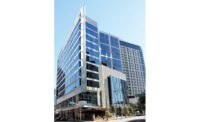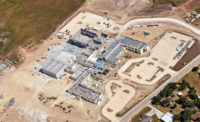There were lots of extremes for builders of Dallas’ newest mixed-use tower, 1920 McKinney, as they faced three months of rain, zero-lot lines and strict noise ordinances to meet an accelerated schedule. But crews are on track to complete the 12-story Class A office building next month with few signs of the project’s travails.
The building, located on McKinney Avenue and Harwood Street adjacent to Klyde Warren Park in the city’s trendy Uptown neighborhood, spans 150,000 sq ft of rentable space. Six levels of office space will be anchored by Invesco Real Estate. Other components include retail space on the ground floor, an 8,000-sq-ft restaurant and about 470 parking spaces spanning three levels below grade and on Levels 2 through 7. The developers declined to reveal the cost of the project.
Going Up
Before work could start on the job, which sits on an urban infield site of just under 1 acre, crews had to tackle some soil remediation and underground unknowns.
“It was ultimately a brownfield construction site,” says Jeff Innmon, vice president of design and construction at KDC, the project’s development manager. “We did have a small existing building to take down, some asbestos to abate and some underground storage tanks associated with previous construction [to contend with].”
Completed projects surround 1920 McKinney on three sides, and the fourth side faces what will be the parking lot of another ongoing project. Additional residential projects in the surrounding area add to complexities on the “postage stamp” site.
“Adjacent residential condos required the project team to comply with city noise ordinances to minimize the impact to neighboring residents, and with additional construction projects underway near the project, site logistics were particularly challenging,” says Matt Robben, project manager for contractor McCarthy Building Cos. “Due to downtown residential requirements, we can only work 12-hour shifts, six days a week. Further, we were restricted to start concrete deck pours after 9 a.m.” He notes that decks typically are poured around midnight to minimize disruption to traffic flows during a regular work day.
In fact, according to the Dallas Business Journal, the new tower was the subject of much debate with residents at a neighboring building who had placed zoning restrictions on the adjacent property. The publication says that Phillip Kingston, a Dallas city councilman, led a mediation that resulted in a $500,000 settlement, a case he said would be an example of zoning issue mediation.
A zero-lot line required McCarthy to turn to just-in-time delivery for all materials and to coordinate scheduling to ensure the team was able to maximize work schedules, skilled crafts and crane time as well as ensure the safety of passers-by at the busy site, Robben adds.
The accelerated 15-month project time frame required creative scheduling techniques to maximize efficiencies and ensure the schedule could be maintained, says Robben. This included pull planning scheduling, hour-by-hour crane use for deliveries, daily coordination and schedule meetings and material prefabrication.
The wettest season in Dallas-Fort Worth history further challenged progress. “We lost about three months of time due to weather on the project, [which] also happened to coincide as we were digging the three-story basement,” Robben says. That made scheduling movement of material and labor even more vital to ensure workforce productivity. The weather issues prompted the owner to grant the rain delays as a non-compensable delay, he notes.
McCarthy’s team has also done everything possible to accelerate the schedule, Robben says. Fast-tracking steps include using two free-standing cranes with a total hook height of 280 ft, a 240-ft man boom lift, prefabricated plumbing rough-in items and prefabricated long-pan forms for the cast-in-place concrete structure, as well as BIM modeling. Column steel rebar was also tied off site and then delivered to the project.
“The boom lift helped accelerate the schedule because swing stages were not an option,” Robben explains. “Scaffolding the building was the other option. However, it would take five weeks to build the scaffold and then perform the work followed by another five weeks to remove the scaffolding. Due to these schedule constraints, the best option was renting the boom lift.”
The facade also presented problems. Seven different components tie in together at numerous locations to complete the extensive exterior skin package.
“The exterior skin and design of the building has a ‘fin,’ which has presented some challenges,” Robben adds. He defines the fin as an aluminum composite metal panel system that outlines the exterior building facade on the north face.
Accessing the work area proved most challenging because the fin wraps around the entire building, protruding off the building face by 18 ft and 210 ft up in the air. The team only had a ¼-in. tolerance in the system, which includes the concrete and back-up structural steel tolerances, says Robben. “This required an ongoing coordination effort and verification to make sure everything was plumb and true to the building within ¼ inch.” The team also held a weekly exterior skin scheduling meeting to coordinate that part of the project.
Team Building
Development manager KDC got involved with the job when approached by leasing firm JLL and a confidential client, and ultimately Invesco Real Estate as part of that project investment team, KDC manager Innmon says.
Not long after, the combined team selected BOKA Powell to be the architectural leader on the project. McCarthy was chosen in August 2014, with official groundbreaking in September. The 1920 McKinney project is McCarthy’s fourth with KDC.
The project team’s scope includes construction of the shell and sitework, while “the restaurant and tenant design are separate scope that’s not included,” Innmon explains. Since KDC and the ownership team needed a quick as possible start and had McCarthy onboard before drawings were complete, they chose a guaranteed maximum price delivery method.
“Zero Heroes”
McCarthy maxed out on site with about 180 employees each day at the peak. After recording a total of 187,248 man-hours by early March, the project also achieved “Zero Hero” status for 2014 and 2015—“meaning there was zero incidents and lost time injuries” says Robben, adding that the same designation applies so far this year.
Preplanning was critical to making that possible, Robben explains. “This required detailed scheduling and planning to maximize the number of work areas available for multiple trades to work simultaneously.” Additionally, “We use BIM 360 to track safety issues to make sure they are completed and checked off,” he says.
Innmon says the project is tracking LEED Silver, and may reach Gold, “if a few of our objectives are achieved.”









Post a comment to this article
Report Abusive Comment